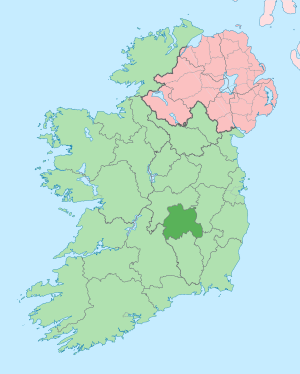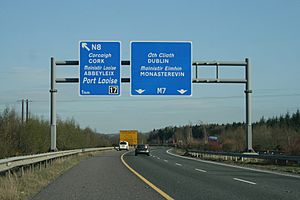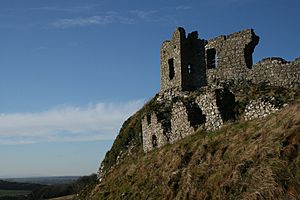County Laois facts for kids
Quick facts for kids
County Laois
Contae Laoise
|
||
|---|---|---|
|
||
| Nickname(s):
The O'Moore County
|
||
| Motto(s):
Irish: I bpáirt leis an bpobal
"In partnership with the community" |
||
 |
||
| Country | Ireland | |
| Province | Leinster | |
| Region | Eastern and Midland | |
| Established | 1556 | |
| County town | Portlaoise | |
| Area | ||
| • Total | 1,720 km2 (660 sq mi) | |
| Area rank | 23rd | |
| Highest elevation
(Arderin)
|
527 m (1,729 ft) | |
| Population
(2022)
|
||
| • Total | 91,657 | |
| • Rank | 23rd | |
| • Density | 53.29/km2 (138.0/sq mi) | |
| Time zone | UTC±0 (WET) | |
| • Summer (DST) | UTC+1 (IST) | |
| Eircode routing keys |
R32 (primarily)
|
|
| Telephone area codes | 057 (primarily) | |
| Vehicle index mark code |
LS | |
County Laois (leesh; Irish: Contae Laoise) is a county in Ireland. It's located in the Eastern and Midland Region and is part of the Leinster province. From 1556 to 1922, it was known as Queen's County. The county's current name comes from Loígis, an old kingdom. It was also sometimes called County Leix.
Laois County Council is the local government for the county. Its main office is in Portlaoise, which is the county town.
In 2022, the population of County Laois was 91,657 people. This was a big increase of 56% since 2002!
Contents
History of County Laois
Ancient Times: Early Settlers
The first people in Laois were hunters and gatherers. They arrived about 8,500 years ago. They hunted in the forests and fished in the rivers. They also gathered nuts and berries to eat.
Later, around 4000 to 2500 BC, Ireland's first farmers came. They cleared forests to plant crops. You can still see their ancient burial mounds in Clonaslee and Cuffsborough.
Around 2500 BC, people from the Bronze Age lived here. They made weapons, tools, and beautiful gold items. You can visit a stone circle they left at Monamonry. There are also remains of their hill forts at Clopook and Monelly. Near Borris-in-Ossory, at Skirk, you can find a Bronze Age standing stone and a ring fort.
After that came the pre-Christian Celtic Iron Age. Iron was first used in Ireland during this time. People fought battles for land using iron weapons. Archaeologists have found ring barrows from this period at Ballydavis.
The county's name, Laois, comes from Loígis, an old kingdom. In the 11th century, the rulers of Loígis took the family name O'Moore. They believed they were related to the famous Red Branch Knights.
By the first century AD, the western part of Laois was part of the Kingdom of Ossory. The eastern part was split into seven areas. These were ruled by the Seven Septs of Loígis, including the O'More, O'Lalor, and O'Doran families.
Christianity Comes to Laois
When Christianity came to Ireland, holy people started religious communities in Loígis. St. Ciarán of Saighir founded his monastery in the Slieve Bloom Mountains. He was the first bishop of Ossory, even before St. Patrick. His mother, Liadán, had an early convent nearby.
Between 550 and 600 AD, St. Canice started Aghaboe Abbey. St. Mochua also founded a religious community at Timahoe. An early Christian group lived at Dun Masc, also known as Masc's fort, on the Rock of Dunamase.
In 1111, the Synod of Rathbreasail was held near Mountrath. This meeting changed the Church from being based in monasteries to having dioceses. As new religious groups with strong ties to Rome arrived, the old wooden churches in Laois were replaced by stone monasteries. The Augustinians and Dominicans settled at Aghaboe Abbey. The Cistercians took over an older religious community at Abbeyleix.
Norman Arrival and Changes
The Norman invasion of Ireland happened in 1169–71. Laois was part of the Kingdom of Leinster, so it was affected. The fortress on the Rock of Dunamase was given as a wedding gift in 1170 to the Norman warrior Strongbow.
The Normans built wooden towers on earthen mounds called mottes to survey the county. They also built strong stone castles, like Lea Castle near Portarlington. Many towns in Laois, such as Castletown, Durrow, and Timahoe, started as Norman settlements.
From 1175 to about 1325, the Normans controlled the best land. The native Gaelic people moved to the bogs, forests, and Slieve Bloom Mountains. But in the early 14th century, the Gaelic chieftains fought back. They pushed the Normans out. The Dempseys took Lea Castle, and the O’Mores gained control of Dunamase. You can still see tower houses built by Irish chieftains at Ballaghmore and Cullahill Castle.
In 1548, the English took the O’Mores' lands. They built a fort called "Campa," which is now Portlaoise.
Queen's County and Plantations

In 1556, Queen Mary officially named the area Queen's County. It included the lands of Leix (Loígis) and other areas. After the Irish War of Independence, Laois got its current Irish name. Portlaoise, which was once called Maryborough, is the main town.
The English tried to colonize Laois twice, in 1556 and 1607. The first attempt by Thomas Radclyffe, 3rd Earl of Sussex failed because the O'Moore clan fought back. This led to a long guerrilla war.
The second colonization after the Nine Years' War was more successful. More English landowners and tenants settled in the area. In 1659, a group of Quakers settled in Mountmellick. In 1696, Huguenots (French Protestants) found safety in Portarlington.
After this, there was a time of peace. Anglo-Irish landowners built beautiful homes like Durrow Castle, Heywood House, and Emo Court. In 1836, a part of the Grand Canal reached Mountmellick, helping local businesses grow.
The Great Famine from 1845–49 caused great suffering in the county. Many people died or had to leave Ireland.
The county was known as Queen's County until 1922. That's when its name was informally changed to Laois after the Irish Free State was formed.
Geography of Laois

Laois is the 23rd largest county in Ireland by both size and population. It's the seventh largest of Leinster's 12 counties. Laois is unique because it's a landlocked county, meaning it doesn't touch the sea. It also doesn't border any other county that touches the coast.
Areas and Towns
The county used to be divided into nine areas called baronies.
There are many towns and villages in Laois. Some of the main ones include:
- Abbeyleix
- Ballinakill
- Ballyfin
- Ballyroan
- Borris-in-Ossory
- Castletown
- Clonaslee
- Durrow
- Emo
- Mountmellick
- Mountrath
- Portarlington
- Portlaoise
- Rathdowney
- Stradbally
- Timahoe
Weather in Laois
You can find out about the weather in Durrow, Laois, by visiting this website. A weather station there measures temperature, humidity, wind, and rain. This helps collect information about the climate in Laois over time.
Government and Politics
Laois County Council is in charge of local government in County Laois. It has 19 councillors who help make decisions for the county. These councillors are divided into three local areas.
Most of County Laois is part of the Dáil constituency called Laois–Offaly. This area elects five people to the Dáil, which is the Irish parliament. Laois is also part of the European Parliament constituency of South.
Fun Places to Visit
County Laois has many interesting places to explore:
- Slieve Bloom Mountains: Great for hiking and enjoying nature.
- Rock of Dunamase: An amazing historic fortress on a hill.
- Emo Court: A beautiful old mansion with lovely gardens.
- Castle Durrow: Another grand castle.
- Timahoe Round Tower: A tall, ancient stone tower.
- Stradbally Hall: A historic house, often hosts events.
- Mountmellick Quaker Museum: Learn about the history of Quakers in the area.
- Ballyfin House: A stunning country estate.
- Dunamaise Arts Centre, Portlaoise: A place for plays, music, and art.
- There are also several golf courses for those who enjoy the sport.
You can also find many old castles, mansions, and forts that are now in ruins but are still interesting to visit.
Population and Economy
The population of County Laois is growing quickly. This is partly because it's easy to travel from Laois to work in places like Kildare and Dublin.
About 70% of the land in Laois is used for farming. However, farming makes up a smaller part of the county's total income than it used to. The rest of the land includes bogs and parts of the Slieve Bloom mountains, which have forests.
Culture and Arts
Performing Arts and Festivals
The biggest theatre in the county is the Dunamaise Theatre in Portlaoise, which opened in 1999.
Laois hosts many fun festivals each year, including:
- Durrow Die-Cast Model and Toy Show
- Halloween Howls
- Laois Bealtaine Festival
- Half Door Club Music & Set Dance Festival
- Rose of Tralee Regional Finals
- Laois Fleadh
- Heartlands Rally
- Gordon Bennett Classic Car Run
- Laois Walks Festival
- Festival Francais Portarlington
- Durrow Scarecrow Festival
- Stradbally National Steam Rally
- National Ploughing Championships
- Electric Picnic
- Maureen Culleton Festival of Dance
- B.A.R.E in the Woods
- Fisherstown Trad Festival
- Ossory Agricultural Show
- William Edmundson & Friends Gathering
- Mountmellick Drama Festival
- Laois International Golf Challenge
News and Media
You can read local news in the newspaper called The Laois Voice.
Getting Around: Railways and Roads
Train Travel
Iarnród Éireann train services connect County Laois to other parts of Ireland. Trains on the Dublin-Cork line stop at Portarlington, Portlaoise, and Ballybrophy. From Portarlington, you can also catch trains to places like Galway and Westport. From Ballybrophy, trains go to Limerick.
In the past, there were train stations in Mountmellick and Abbeyleix, but they closed in the 1960s.
Road Travel
The M7 road goes through County Laois. This is one of the busiest roads in Ireland, connecting Dublin and Limerick. It's also part of the route for the M8, which links Cork to Dublin.
Roads in Laois have improved a lot. Many major routes are now motorways. Towns like Abbeyleix and Mountrath used to have a lot of traffic jams, but new bypasses opened in 2010 have made travel much smoother.
Bus Éireann offers regular bus services in the county. Buses run frequently between Dublin and Limerick, and between Dublin and Cork, passing through towns in Laois.
Famous People from Laois
Many notable people come from County Laois, including:
- Darina Allen (1953– ): A well-known TV chef.
- Claire Byrne (1976– ): A popular TV presenter and newscaster.
- Cecil Day-Lewis (1904–1972): A famous British Poet-Laureate.
- Eileen Dunne (1958– ): A TV newscaster.
- Stephen Hunt (1981–): A professional footballer who played for Ireland.
- James Fintan Lalor (1807–1849): A significant figure in Irish history, part of the Young Ireland movement.
- Peter Lalor (1827–1889): Led the Eureka Stockade miners' revolt in Australia.
- Kevin O'Higgins (1892–1927): An important politician and Minister for Justice.
- Robert Sheehan (1988– ): An actor known for his roles in TV shows like Misfits.
- Professor Noel Fitzpatrick (1967–): A famous veterinary surgeon from the TV show The Supervet.
- Fionn mac Cumhaill: A legendary hunter-warrior from Irish mythology.
Sports in Laois
Laois has a strong tradition of Gaelic games, including Gaelic football and hurling. Laois is one of the few counties that has played in an All-Ireland final for both Gaelic football and hurling.
In recent years, Laois footballers have been quite successful. The Laois minor teams have won several championships. The senior footballers reached the Leinster final in 2003 (which they won), 2004, and 2005.
As of 2022, Laois hurlers compete in the Liam MacCarthy Cup, which is for the top hurling counties. The footballers compete in the Sam Maguire Cup. Laois plays its home games at O'Moore Park in Portlaoise, which is the county's largest sports venue.
In rugby, the teams Portlaoise RFC and Portarlington RFC play in the Leinster League.
Twin Towns
County Laois is twinned with several places around the world:
 Arlington, Massachusetts, United States
Arlington, Massachusetts, United States Carleton Place, Ontario, Canada (since 2008)
Carleton Place, Ontario, Canada (since 2008) Coulounieix-Chamiers, France (since 1996)
Coulounieix-Chamiers, France (since 1996) Franklin, Tennessee, United States (since 2008)
Franklin, Tennessee, United States (since 2008)
Images for kids
See also
 In Spanish: Condado de Laois para niños
In Spanish: Condado de Laois para niños
- List of abbeys and priories in the Republic of Ireland (County Laois)
- List of towns and villages in Ireland
- Lord Lieutenant of Queen's County
- High Sheriff of Queen's County






